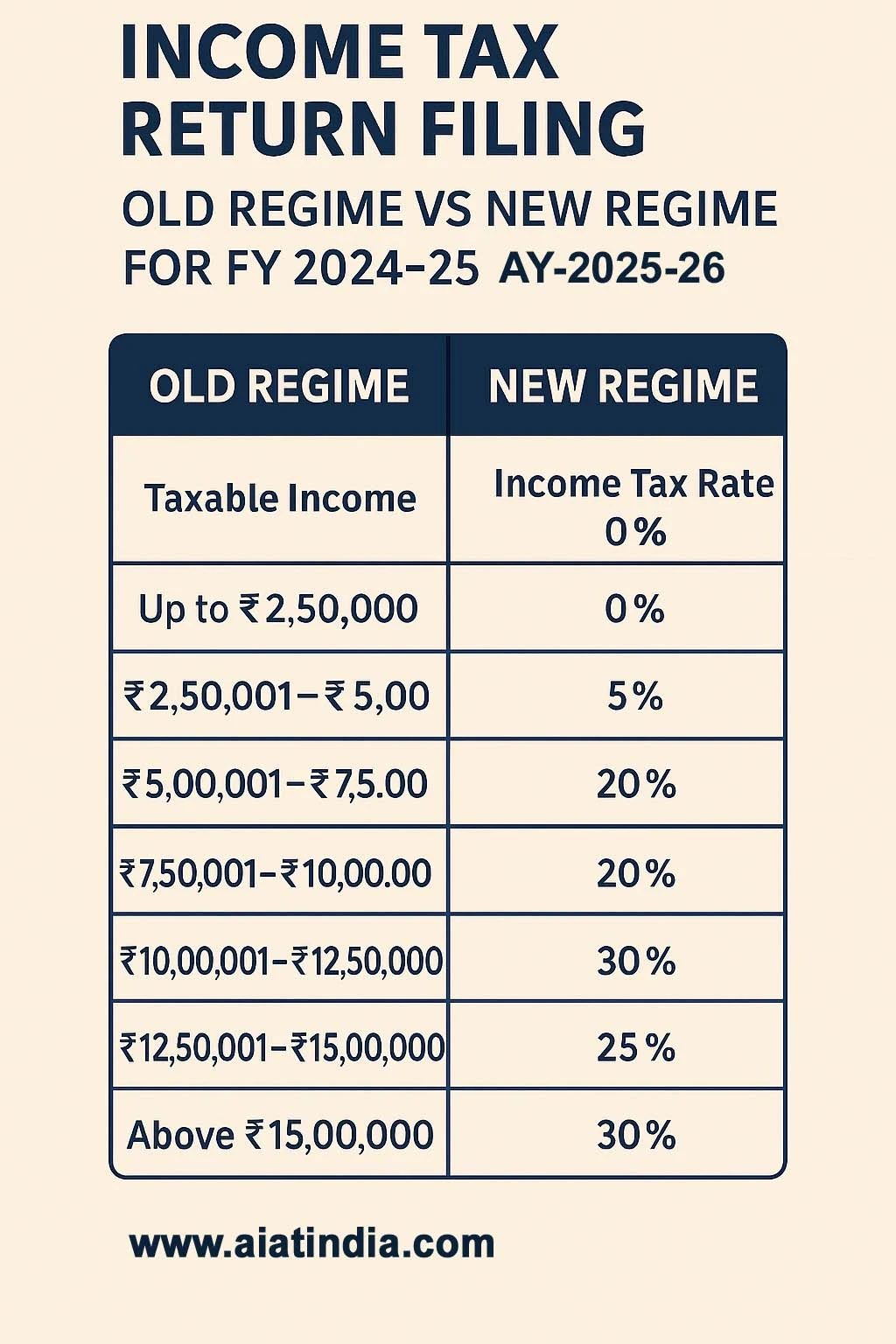
Income Tax Return Filing: Old Regime vs. New Regime (FY 2024-25)
For the Financial Year (FY) 2024-25 (Assessment Year AY 2025-26), taxpayers in India have the option to choose between the Old Tax Regime and the New Tax Regime while filing their Income Tax Return (ITR). Both regimes have different tax rates, deductions, and exemptions. Below is a simple and detailed comparison:
1. Key Differences Between Old & New Regime
|
Feature |
Old Tax Regime |
New Tax Regime (Default from FY 2024-25) |
|
Tax Slabs |
Higher tax rates but more deductions |
Lower tax rates but fewer deductions |
|
Deductions (80C, 80D, HRA, etc.) |
Allowed (e.g., Section 80C, 80D, HRA, LTA) |
Most deductions not allowed (except a few like NPS, Standard Deduction of Rs.50,000 for salaried) |
|
Standard Deduction (Salaried) |
Rs.50,000 allowed |
Rs.50,000 allowed |
|
HRA Exemption |
Allowed |
Not allowed |
|
LTA (Leave Travel Allowance) |
Allowed |
Not allowed |
|
Interest on Home Loan (Section 24) |
Allowed (up to Rs.2 lakh) |
Not allowed |
|
Tax Rates (FY 2024-25) |
Higher (see table below) |
Lower (see table below) |
|
Best for |
Those with high investments & deductions |
Those with minimal deductions & simple income |
2. Tax Slabs for FY 2024-25 (AY 2025-26)
A. Old Tax Regime (With Deductions)
|
Income Range (Rs.) |
Tax Rate |
|
Up to Rs.2.5 lakh |
Nil |
|
Rs.2.5 - Rs.5 lakh |
5% |
|
Rs.5 - Rs.10 lakh |
20% |
|
Above Rs.10 lakh |
30% |
|
Surcharge (if income > Rs.50 lakh) |
10-37% |
|
Health & Education Cess |
4% on tax |
B. New Tax Regime (Default, Fewer Deductions)
|
Income Range (Rs.) |
Tax Rate |
|
Up to Rs.3 lakh |
Nil |
|
Rs.3 - Rs.6 lakh |
5% |
|
Rs.6 - Rs.9 lakh |
10% |
|
Rs.9 - Rs.12 lakh |
15% |
|
Rs.12 - Rs.15 lakh |
20% |
|
Above Rs.15 lakh |
30% |
|
Rebate (Section 87A) |
Full tax rebate if income ≤ Rs.7 lakh (vs. Rs.5 lakh in old regime) |
|
Surcharge (if income > Rs.50 lakh) |
10-37% |
|
Health & Education Cess |
4% on tax |
3. Which Regime is Better for You?
Choose the Old Regime if:
✔ You have high investments (PPF, ELSS, Insurance, Home Loan, etc.)
✔ You claim HRA, LTA, or other exemptions
✔ Your taxable income after deductions is much lower
Choose the New Regime if:
✔ You don’t have many deductions
✔ Your income is up to Rs.7 lakh (tax = zero due to rebate)
✔ You prefer simpler tax filing with lower rates
4. Important Points for FY 2024-25
- Default Regime: New tax regime is default from FY 2024-25. If you want the old regime, you must manually select it while filing ITR.
- Salaried Employees: Must declare preferred regime to employer at the start of FY (via Form 12BB).
- Business/Professionals: Can switch regimes yearly, but salaried must stick to one regime for the whole year.
- No switching after filing ITR for that year.
5. Example Calculation (Old vs. New Regime)
Case: Rs.10 lakh salary, Rs.1.5 lakh deductions (80C, HRA, etc.)
- Old Regime Taxable Income: Rs.10L – Rs.1.5L = Rs.8.5L → Tax = Rs.82,500 (after slab benefits)
- New Regime Taxable Income: Rs.10L (no deductions) → Tax = Rs.75,000
Verdict: New regime is better here due to lower tax.
But if deductions were Rs.3 lakh, old regime would be better.